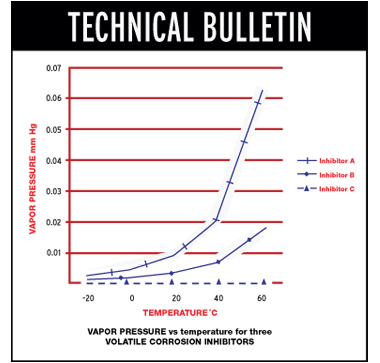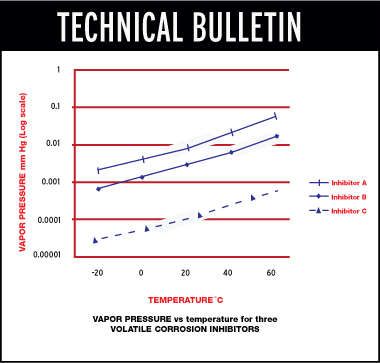In the war against corrosion, ARMOR’s VCI Nanotechnology is your best defense. In this issue, we explain VCI and how volatility, temperature and humidity can affect it.
The strength of Armor Protective Packaging®’s corrosion management products stem from its proprietary ARMOR VCI Nanotechnology. This technology is what we like to call “the power behind the shield,” and it is the rust protection that is a part of ARMOR’s entire product line.
ARMOR VCI Nanotechnology uses “Vapor Corrosion Inhibitors” (VCI) to protect ferrous and non-ferrous metals. Vapor corrosion inhibitors are a class of chemical compounds that emit rust-inhibiting vapors into an enclosed air space. Once released, the VCI molecules circulate in the enclosed area and attach themselves to the surface of metal to form a thin, invisible film to prevent the formation of corrosion.
Volatility
VCIs rely on their vapor pressure to emit their rust inhibitors and to fill an enclosed area. It is desirable for a VCI to provide the rust inhibitor rapidly and to have a lasting effect. Therefore, the compound should have a high enough vapor pressure to saturate all the accessible vapor space as quickly as possible but also have a low enough vapor pressure to sustain protection over a long duration. ARMOR Protective Packaging®’s VCI Nanotechnology is unique in that it uses mixed inhibitor technology, which provides a range of vapor pressures. This VCI nanotechnology is a result of years of research and development and is backed by more than 30 years of field experience.
Temperature/Humidity
Two factors impact the rate of corrosion on metal:
- temperature
- humidity
As temperature and humidity rise, so does the rate of corrosion on the metal. In the instance of temperature, the impact of temperature can be significant. For most packaging applications, processing, storage, and shipping occurs within the temperature range of 32°F/0°C to 167°F/75°C. Beyond this temperature range, the corrosion rate doubles for every 50°F/10°C to 59°F/15°C rise in temperature.
Key Changes that Occur with ARMOR Products Due to Temperature Increase:
- VCI concentration increases in the packaging environment as temperature increases.
- The vapor pressure of any solid or liquid changes dramatically as temperature changes.
- The vapor pressure of any substance increases non-linearly with temperature according to the Clausius–Clapeyron relation.
- The vapor pressure changes by the square of the change in temperature.
The following graph depicts three VCIs that ARMOR uses as part of the mixed inhibitor technology.

Armor Protective Packaging® mixed inhibitor technology provides a range of vapor pressures. High vapor pressure VCI (Inhibitor A) volatizes more rapidly to provide protection as quickly as possible. The lower vapor pressure VCIs (Inhibitor B and Inhibitor C) have low enough vapor pressures to sustain protection over a long duration.
Because the vapor pressure changes dramatically with changes in temperature, the relative vapor pressures can best be viewed on a logarithmic scale. The following graph depicts the temperature/vapor pressure relationship for the three inhibitors utilizing a log scale for vapor pressure.
Humidity can also have a powerful impact on metal corrosion rates. Because moisture provides the electrolyte, which is required for corrosion reactions, humidity is a major factor in metal corrosion. In general, as the level of humidity increases so does the formation of rust or corrosion. The critical level of relative humidity in order for significant corrosion to occur is 60%.
When dealing with humidity, as moisture levels increase, ARMOR VCIs become more active. The presence of moisture increases the concentration of VCI in the air space and on metallic surfaces. Higher humidity levels increase the concentration of VCIs in the enclosed environment. The ARMOR VCI carrier contains corrosion inhibiting ionic compounds. When moisture is present in, and on, the carrier, the ionic compounds partially dissolve to form ions. The vapor pressure of the VCI ion solution is higher than that of the ionic compounds resulting in more VCI being released when moisture is present.
ARMOR’s VCI Nanotechnology responds and adjusts to these temperature and humidity fluctuations, increasing and decreasing as needed. For additional information on ARMOR VCI Nanotechnology and the full line of ARMOR products, visit the ARMOR website at www.armorvci.com or contact your ARMOR sales representative.
